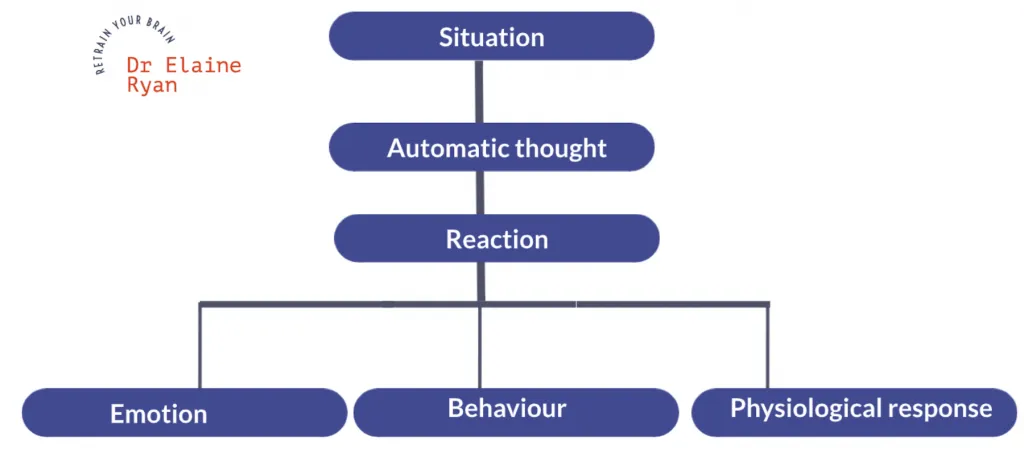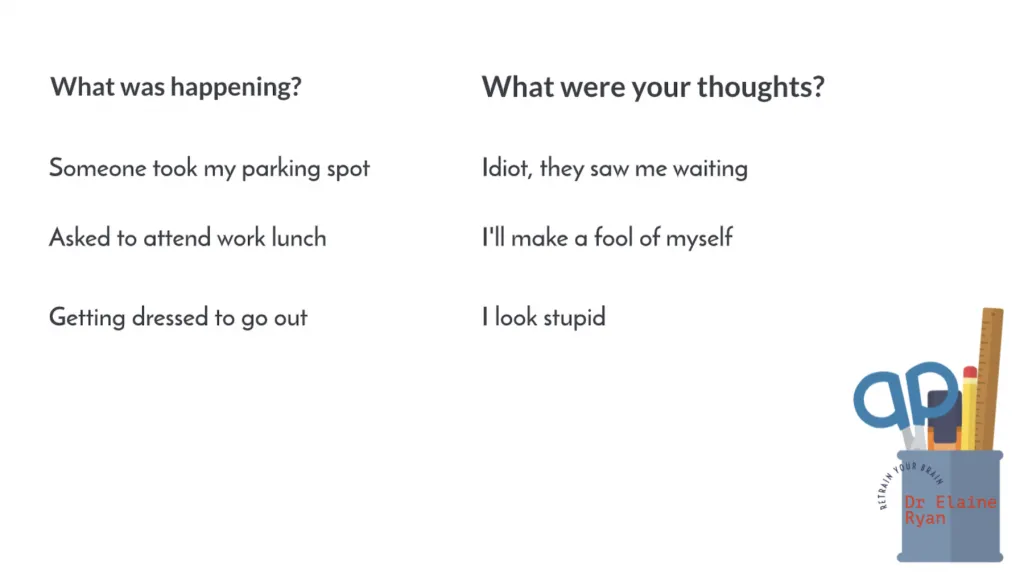Negative automatic thoughts or NATS’s are situation-specific and essential to understand when working with anxiety using CBT.
Everyone gets NATS when they are upset, but if you are experiencing an uncomfortable emotion such as anxiety or anger, it is important not to dismiss these thoughts, as they tend to keep the negative emotion hanging around.
This article is part of a series called Working with anxiety.
The cognitive model, a central feature of CBT (1) is based on an information processing model. The information processing model states that individuals process instead of responding to information around them. This information processing is where we can find errors that shall help you continue to work with your anxiety.
You probably see this chart if you have been reading about BT, and it will help you understand information processing.

Worked example.
A friend walks past you one the street. You immediately think, she doesn’t like me; no one likes me. This makes you feel upset, anxious and you shall ignore her in the future.
In the cognitive part of CBT, the initial thought is paramount as it determines how you feel and behave. If we change the initial thought, the outcome is entirely different.
If you were able to think, she doesn’t see me, this would have changed how you felt and how you behaved.
According to Ledley et al. 2010 (2) distorted thinking underlies all psychological disorders. The cognitive errors in the previous post are all examples of information processing errors or biases.
When experiencing uncomfortable emotions such as anxiety, the person typically distorts information negatively, such as in the example above, where the person thinks that someone did not like them based on the information of someone walking past them on the street.
Quick recap
We process information about situations, and this processing is not always accurate. The errors in processing can result in unnecessary anxiety.
In the previous articles, I introduced you to your thoughts and mistakes you can make in your thinking, and you are ready to start working with negative automatic thoughts using CBT.
Working with NAT’s is necessary because learning how to correct these thinking errors allows you to process information that is more evidence-based, and not subject to distortions that keep you anxious.
Anxiety can be understood (at the cognitive level) by three different thinking styles.
- Negative automatic thoughts
- Assumptions
- Core beliefs
In this article we are looking at NAT’s.
How to work with negative automatic thoughts.
I suggested recording thought processes on this worksheet in the article working with cognitions. This was the start of you recording your NATS.

An easy and effective way to elicit NATs is to be aware of any adverse mood changes, such as anger, sadness, anxiety, and stop and ask yourself what is running through your mind. The answer, your thought, will be your automatic thought.
Worked example.
You waved and shouted hello to me from the other side of the street, and I walked by.
You felt upset and hurt. This is the change in your mood.
She doesn’t want to speak to me and ignores me on purpose; she does not like me, nobody like me. These are your automatic thoughts, and they are negative, hence negative automatic thoughts.
What evidence do you have for those thoughts that are affecting your mood? Can you prove them? For example, can you prove that I ignored you or do not like you? The answer is no, which means there is an information processing error, a cognitive distortion.
In the previous post, I listed cognitive distortions, but I shall list some pertinent ones to help you understand what to do with your negative automatic thought.
The negative thought was – that she did not like me; nobody likes me.
This is mind-reading, as you cannot accurately know what the other person is thinking at that specific moment.
It is also overgeneralising when you think that no one likes you.
Once you have identified the errors in your thinking, you have to develop a more balanced thought based on the factual information at hand. Note. It is all about processing information.
An example would be my friend did not ignore me; she did not see me.
What effect does this have on the chart?
You can see that the outcome is entirely different in terms of emotional reaction.
Working with your NTA’s is not positive thinking. In my 20 years of working as a psychologist, this is a common misconception that CBT is positive thinking.
CBT is not replacing negative thoughts with positive ones. CBT is to replace unhealthy maladaptive thoughts with more evidence-based, adaptive thoughts. (3)
How to address difficulties that may arise when working with NAT’s
People often struggle to come up with a more balanced, evidence-based thought. This struggle is usually due to having such a fixed thinking style for many years that it is almost impossible to see the situation or yourself differently.
A good solution is to pretend that it is happening to someone else, as this can free up your thinking. Based on the evidence, if a friend was upset because someone did not wave at them on the street and is convinced that no one likes them, what would you say to them? If your answer was, they did not see you; this is the more balanced thought.
Recap
We all experience negative automatic thoughts, but if you are experiencing anxiety, you need to work with these thoughts to help you change the emotion. This is just one part of working with the cognitive part of cognitive behavioural therapy, and in the next post, we shall be looking at assumptions and how to work with those.
- Beck Institute https://beckinstitute.org/about/intro-to-cbt/
- Ledley, D.R, Marx, B.P., and Heimberg, R.G. (2010) Making Cognitive Behavioural Therapy Work, 2nd end, New York: Guilford.
- Beck AT, Dozois DJ. Cognitive therapy: current status and future directions. Annu Rev Med. 2011;62:397-409. doi: 10.1146/annurev-med-052209-100032. PMID: 20690827.
